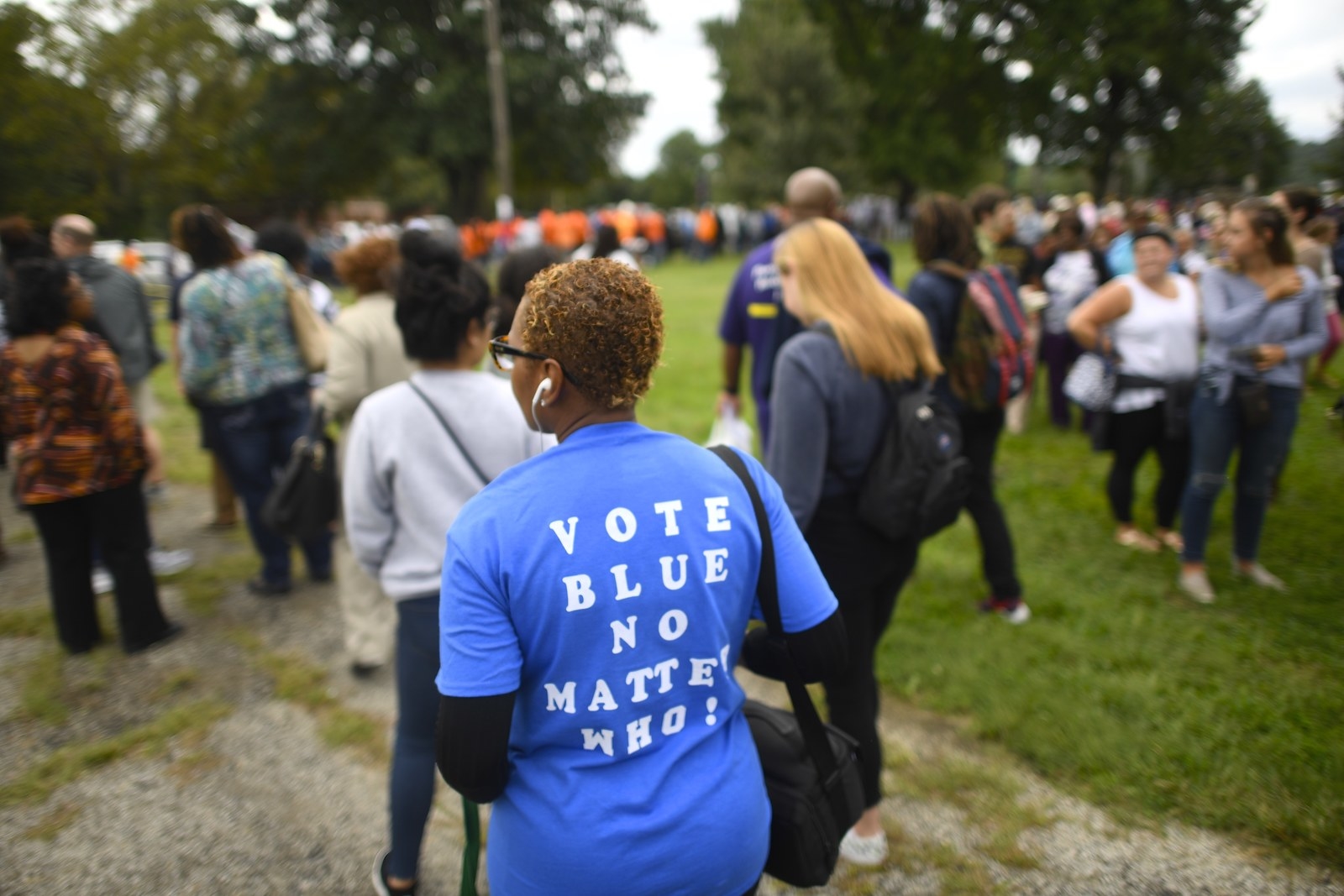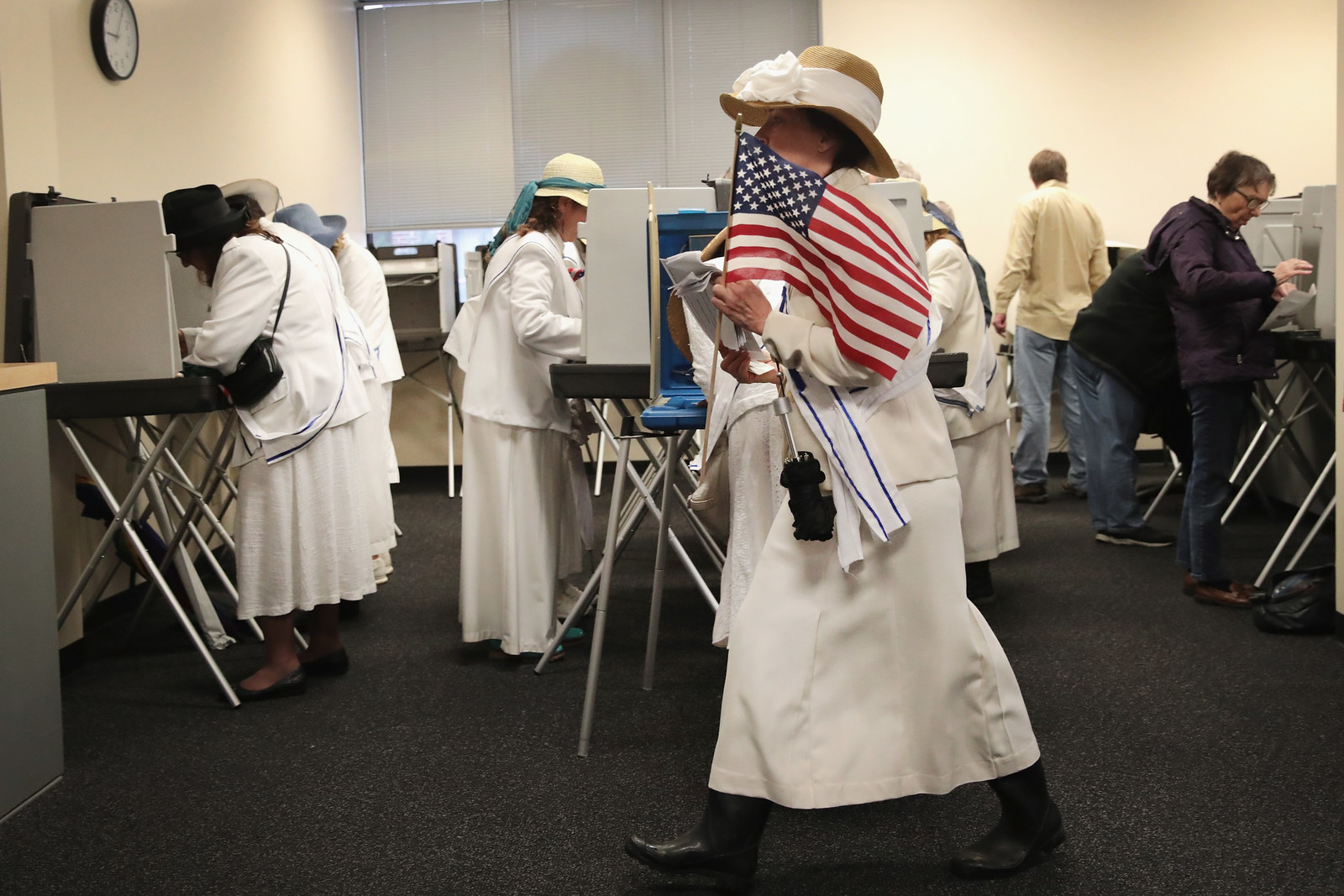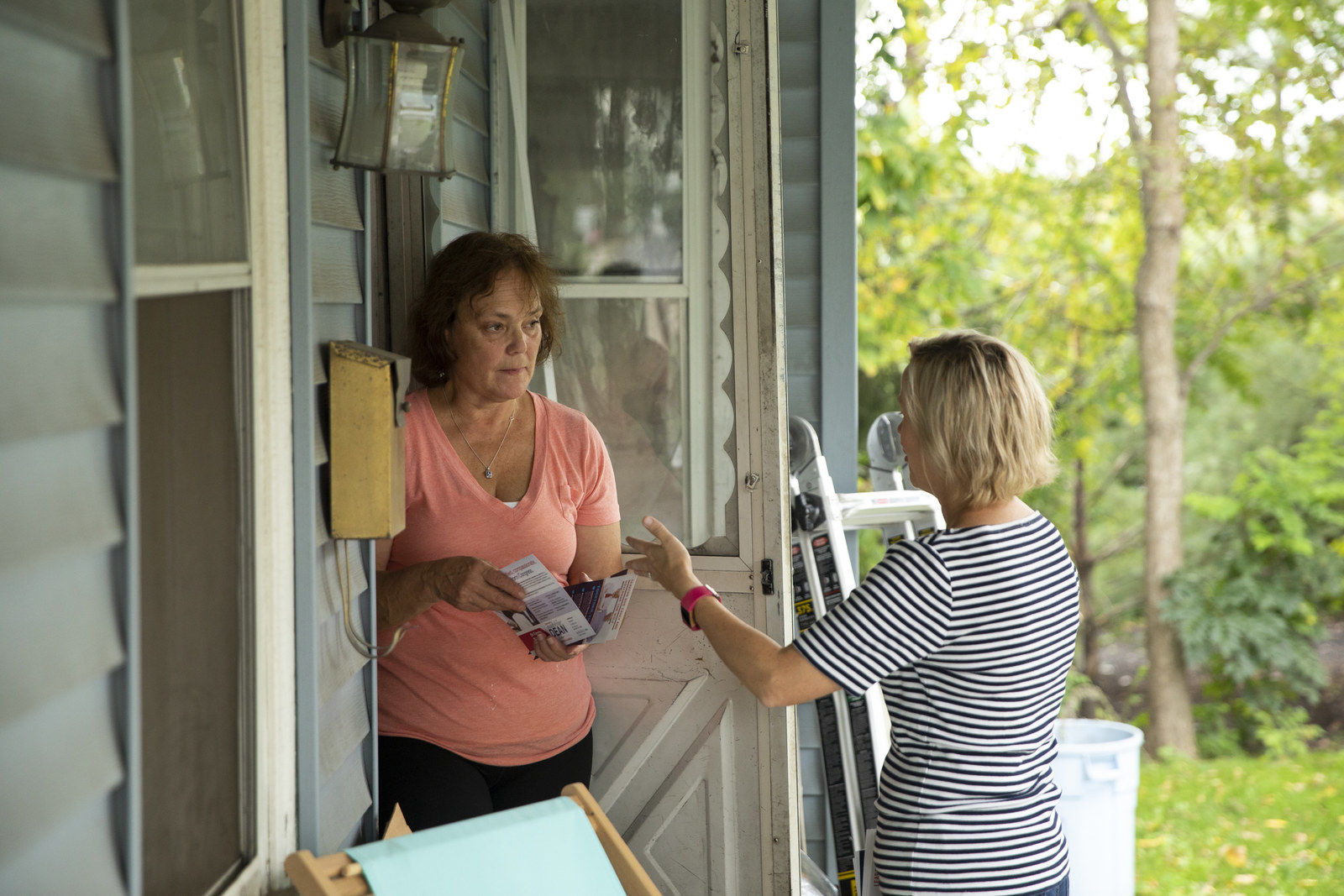
The popular face of this year’s elections on the American left may well be Alexandria Ocasio-Cortez, a young democratic socialist who shocked the Democratic establishment in New York City. But if there is a blue wave this year, the real driving force will be the country’s politically moderate suburban women.
Since the election of Donald Trump, many have turned their backs on the Republican Party, and many others have become politically engaged for the first time in their lives. Suburban women are rallying to take control of Congress away from Trump — and potentially to take over the Democratic Party.
Once reliably Republican-voting, college-educated white women — who make up a large portion of women voters in the suburbs — flipped from Mitt Romney to Hillary Clinton in 2016 by a narrow 6-point margin. That gap is now a chasm. In a poll of 59 battleground House races nationwide, college-educated white women now favor Democrats over Republicans by nearly 30 points.
College-educated and suburban women are also the group perhaps most energized in this year’s election campaigns. If Democrats take Congress, it’ll be suburban women’s interests that get them there: less socialism, more education reform; less Medicare for All, more Affordable Care Act; less political battling, more bipartisanship.
Conversations with more than three dozen suburban women voters across three swing districts in Pennsylvania, Michigan, and Minnesota illuminate that stark shift. For many of these women, a longstanding personal dislike of Trump has seeped into the Republican Party since the 2016 election — even to many Republican incumbents who have scrambled to distance themselves from the president.
A similar refrain from women who had voted Republican: Not this time.
More than a dozen women who said they voted for Republicans in those districts in the past — splitting tickets or even voting straight down a party line — echoed a similar sentiment: Not this time.
The 2018 midterm hinges on voters like them. They live in suburbs that have long been Republican strongholds, and in states that moved heavily toward Trump in the 2016 election. But in 2018, many of those suburbs have become swing districts, with their Republican incumbents at risk of losing their seats.
The question isn’t so much if these voters will leave Republicans this year, but whether the shift is permanent — whether Republicans have, in the space of a few years, lost a demographic that they once relied on.
Many of the women interviewed said they plan to vote for Democrats in 2018 because they have seen something change in the Republican Party in the wake of Trump’s election. They expected a Republican Party that would moderate the president rather than remake itself in his image — an attitude that led some women to vote for Republicans alongside Clinton, or to take a chance on Trump himself.
These voters want someone who will keep Trump’s worst impulses in check — and they no longer have faith that Republicans will do that.
Pam, an independent voter in a reliably Republican district in Michigan who did not want her last name used, said she was planning to vote for Democrats this year after years of splitting tickets in favor of moderation and balance. If Ohio Gov. John Kasich, a Republican moderate, had run in 2016 instead of Trump, she said would have voted for him.
Asked if she would vote for a Republican again, she said yes, on one condition: “They need to stop being the party of Trump.”
Something has shifted for left-leaning women, too, after the 2016 election, which they believed Hillary Clinton would win. In interviews, they spoke of becoming increasingly engaged and energized by politics, often for the first time, after Trump took office: volunteering, running for office, marching. One woman called it “waking from my political coma.”
Both shifts are likely to remake the Democratic Party. A flood of newly engaged women has given the party a plethora of high-quality women candidates — veterans, teachers, nurses — and volunteers that will carry it past the midterms, helping Democrats cement their image with women voters.
But the Democratic Party that has been surging leftward, particularly ahead of the 2020 election, will also have to hold on to suburban women voters if they want to take back the presidency in states like Pennsylvania.
These suburban and college-educated women who increasingly align themselves with the Democratic Party also described themselves mostly as moderates — even those who knitted pink pussy hats and set out to march last January. They are looking for a Congress that compromises, and representatives who will fill a gap left by a Republican Party that they think has drifted too far toward Trump.

When Kris Miner voted for Republican Rep. Erik Paulsen in 2016, she thought of him as a moderate — a friendly, bespectacled lawmaker who had represented her district in the wealthy Minneapolis suburbs for eight years.
Miner is left-leaning, she said, and she has no warm feelings for Trump, but she tends to split her votes between Democrats and Republicans, looking for balance in government. “I wanted fiscal responsibility,” Miner explained of her vote for Paulsen. “I thought he was doing just fine. The world wasn’t crazy, and I didn’t really do much research.”
Clinton won Paulsen’s district, Minnesota’s 3rd, by almost 10 points that year, and Paulsen sailed to an even easier victory, winning by 14.
Trump’s election moved Miner, a devout Christian and stay-at-home mother, to attend the Women’s March that January, the first time in her life she’d ever been to a political march. At first, though, she felt hopeful about Paulsen’s election, thinking he would be a moderate balance to Trump’s far-right policies.
But as she watched Paulsen align with Trump and the rest of his party again and again, voting for the repeal of the Affordable Care Act and helping craft the party’s signature tax bill, Miner said she was “horrified.”
Before now, voting felt less urgent. “The world wasn’t crazy, and I didn’t really do much research.”
“It’s a time when he really needed to be courageous, and to have a backbone — to do what he was elected to do,” Miner said. “But he’s more concerned about keeping his president, his party, and his political backers happy.”
Paulsen has remained as far away as possible from the unpopular president while campaigning in 2018. Trump has been to Minnesota for two rallies in recent months, flanked onstage by much of the party’s slate, but Paulsen’s name hasn’t even been mentioned. In a recent debate with his Democratic challenger, Dean Phillips, Paulsen promised to stand up to Trump and his party when he felt it was necessary.
But Trump has colored him nonetheless. Just two years after his comfortable victory, Paulsen is one of the House’s most endangered Republicans.
Across the country, Democrats have opened a wide lead in the race for the House, and polls have found repeatedly that women are driving it. This summer, a Los Angeles Times/USC poll found Democrats led among suburban women by 17 points; by late September, it had grown to 26 points.
“Many of them have been Republicans for economic reasons. They’re not cultural warriors, they’re pro-choice,” said Bob Shrum, a USC professor and former Democratic consultant, of suburban women voters. “They don’t like the way the president conducts himself.”
Among women, Democrats have also carved into deficits in other staunchly Republican demographics. Married white women favor Republicans just 51% to 46% and are narrowing a gap with white women without college degrees.
Dislike of Trump was a consistent undercurrent in dozens of interviews with women of all political stripes across the suburbs of Michigan, Minnesota, and Pennsylvania. It went beyond his tweets, many said, to his personality — the way he treated people, particularly women, and the upheaval of his governing.
Many women care about issues like health care, education, and choice. But Trump, more than a dozen women said, was driving their votes — and fueling their decision to align with Democrats.
Valerie McCarthy, a registered Republican in the Philadelphia suburbs, said she’s found herself increasingly drifting toward Democrats, though she feels little allegiance to either party. She hasn’t found many issues she cares strongly about this midterm election, she said — except one.
“Oh god, there’s so many things. I don’t think he’s qualified,” she said of Trump. Then there was the fact that he’d been accused of sexually assaulting women — something she had been reminded of repeatedly as she watched Supreme Court Justice Brett Kavanaugh’s confirmation hearings, and listened to Trump talk about the woman who had accused Kavanaugh of sexual assault.
Asked if she would vote for a Republican this term, McCarthy shook her head. “A few years ago, I would have — I'm not strict,” she said. “Not this time.”

“Now I’m Democratic. I’ve never been before,” said Bobbie, a retired woman spending a morning browsing the shops of Birmingham, Michigan, an idyllic suburb of Detroit. “But I care about our Constitution.” She’s split tickets between Republicans and Democrats before, she said, but now? “Absolutely not. I don’t see myself voting for any of them.”
“Embarrassed” was how Dawn, a longtime Republican from Birmingham, said she felt about the Trump administration. It was the same way she’d felt about Republicans in 2008, she said, when John McCain, a man she deeply admired, picked Sarah Palin as his running mate.
“I haven’t done much research on candidates yet,” Dawn said. “But I can tell you it won’t be a Republican.”
Kris Miner, in Minnesota, was so upset by Rep. Paulsen’s alignment with Trump that she decided to volunteer for Phillips, his Democratic opponent. At a postcard-writing party she hosted at her home in Eden Prairie for Phillips this summer, some 30 people showed up. Twelve, she said, had been one-time Paulsen voters.
Miner is done splitting tickets, at least for now. She’s long been a fan of her local state senator, a Republican who broke with her party to support gay marriage, but Miner won’t even vote for a local Republican now. “I feel very loyal to her,” Miner said of her senator. “But this time, I feel like there’s too much at stake. We can’t afford to have even a moderate in office, even though I know she’s a good person.”
“We can’t afford to have even a moderate in office, even though I know she’s a good person.”
Even some women who liked the president’s policies or planned to vote for Republicans in November said they have little affection for the president himself.
Jan, in Blue Bell, Pennsylvania, voted for Trump because she wanted to “see change,” she said, and so far she’s liked what he’s done with the economy. “I’m a Republican for economic issues, and a Democrat for social ones,” she said.
Did she want a congressperson who would keep Trump in check, or help him? She laughed. “I don’t know that anyone can help him,” she said. “He’s such a dogmatic egoist.”
White women have been the focus of a central political argument since the 2016 election, when exit polls found they voted for Trump 52–43%. Even though that number has since been debunked by validated voter data, which shows Trump won white women with a narrow 47–45% margin, Trump regularly cites it as proof that he has widespread support among women.
Though many of Trump’s voters haven’t wavered in their support of the president, there is one small but notable exception: Fourteen percent of women with a college degree now harbor “very cold” feelings toward the president — compared with just a tiny fraction who felt that way immediately after the election.
Still, 74% of educated women who voted for Trump still say they feel warm toward the president. One of them is Deb O’Hagan, a voter in Michigan’s 11th District. It wasn’t always that way: In the 2016 primaries, she jumped from supporting Carly Fiorina to Ben Carson to Ted Cruz before finally backing Trump. But she says she hasn’t looked back since.
Now O’Hagan says she’s “amazed” and “thrilled” by Trump’s performance. And in her swing district, she thinks there are more women like her than the polls show. A few weeks ago, spending time with a group of friends who pay little attention to politics, she discovered that even her left-leaning friends support Trump’s policies, O’Hagan said — even if they didn’t like his tweets.
“I was surprised by that,” O’Hagan said. “I keep hearing the pundits talk about suburban women and all that. But if you talk about his actual policies, people will give you a different answer.”

On the campaign trail in Michigan’s 11th District, in the leafy upscale suburbs of Detroit, Democratic candidate Haley Stevens has homed in on one question to connect with voters: “What do you do?”
“We’ve got a booming economy,” Stevens told BuzzFeed News. “So I’m talking to people about their work in engineering. I’m talking to dual-income households. You ask what people do — that’s how you get enthusiasm.”
The prosperous district, which twists and turns to avoid some of the bluest areas of the Detroit suburbs, hasn’t elected a Democrat to a full term since the 1960s. Stevens has built a campaign there squarely around jobs and the economy: She led Barack Obama’s auto rescue efforts in Michigan in the wake of the recession, and her ads claim she “saved over 200,000 jobs” and emphasize her support of workforce training programs. (Her opponent, Lena Epstein, was Trump’s campaign chair in Michigan, helping the president eke out a narrow but shocking victory in the state in 2016.)
Asked if she considers herself a moderate Democrat, Stevens said she’d call herself a “pragmatic problem-solver.”
Her policies, for the most part, put her squarely in the middle of the Democratic Party. Stevens stays away from Medicare for All, the Bernie Sanders-backed proposal for a single, government-run health care plan embraced by many Democrats. Instead, she said the government should allow people to buy into a public Medicare-like option.
“I am really focused on infrastructure,” Stevens told BuzzFeed News. “I’m really focused on workforce training, on public education. I’m willing to work with anyone to get these things done.”
“I like a candidate who’s a moderate, really.”
In Stevens’ district and more than a dozen suburban districts like it, where Democrats are hoping to win for the first time in decades, it’s these kinds of pragmatic politics that have proved popular with voters, winning primaries over more liberal opponents. Stevens won a crowded primary race, handily beating a candidate backed by Alexandria Ocasio-Cortez.
In primaries in dozens of swing districts, candidates backed by the Democratic Congressional Campaign Committee — an establishment group that tends to favor moderates — won all but two of their primaries, frequently over progressive challengers.
“I like a candidate who’s a moderate, really,” said Jan Levin, who lives in Pontiac, Michigan, next to Stevens’ district. “I care about health care and education, things like that.”
Across districts and party registrations, many women said they were voting for Democrats this year because they want candidates who would get things done in a dysfunctional Congress, balancing out what they see as Trump’s chaotic, firebrand politics.
That also applied to women who had joined the so-called anti-Trump resistance, donning pink hats at the Women’s March and volunteering for political candidates for the first time in their lives.
“I’m a moderate, fiscally conservative, socially accepting person,” said Sarah Eigenmann, in Paulsen’s Minnesota district. Eigenmann likes to say she “was in a political coma my whole life,” voting for Republicans and Democrats alike, including, at one point, Paulsen. “Frustrated” and “angry” about Trump's election, she joined a local branch of Indivisible, the anti-Trump Democratic organizing group, and began to volunteer for Phillips.
Like Stevens, Phillips has danced carefully around Medicare for All. Eigenmann appreciates that. “It doesn’t make sense for a two-year candidate to be talking about ‘I want single-payer,’” she said. “If we started a brand-new country tomorrow, maybe single-payer would make sense, but we’re not there. We can’t just take away what people have.”
Few of the Democrats nominated in key suburban districts campaigned on promises like Medicare for All or free college tuition — rallying cries of some of the biggest figures in the national Democratic Party. And that matters to some of Phillips’s staunchest supporters.
“I wouldn’t say I was extremely progressive,” said Karen Siegman, of Shorewood, Minnesota, who is volunteering for Phillips — her first time getting involved in politics. “I don’t believe socialism works. I know some of the wings of the progressive left are a little bit socialistic. I’m not so much a fan of that.”

Maria Collett had never run for office before this year, but by now, crisscrossing her neighborhood in Ambler, Pennsylvania, she’s an old hand at it: thumbing through addresses and names on a canvassing app, offering warm introductions through skeptically opened screen doors.
“We really do have a chance to flip this seat,” Collett, a Democrat running for a state Senate seat in the Philadelphia suburbs, says to a woman who answers the door in a pro–gun control T-shirt.
“I’m a nurse, so I’ve been fighting for people for a long time,” she tells a woman balancing a baby on her hip, who says she plans to vote to restore civility and bipartisanship.
“I live right around the corner from the Y,” she says to a lifelong Democrat who brings her granddaughter, newly voting-age, onto the porch alongside her, a menagerie of animals squawking behind them.
When men answer the door, Collett often glances at her app, then asks: Are their wives home?
The mother of a young son, Collett decided to become involved in politics for the first time in the wake of Trump’s election in 2016 — something that she realizes makes her part of something akin to an army of left-leaning women, reeling in the wake of Trump’s victory.
She got involved in the campaigns of local municipal elections, which gave her the courage to run herself, hoping she could offer lessons from her time working in the health care system, as well as her own experiences with her husband’s chronic leukemia diagnosis.
“After 2016, I realized that paying attention wasn’t enough.”
“After 2016, I realized that paying attention wasn’t enough,” Collett said. “I went out and did my civic duty. I was a nurse, and nurses fill gaps — there’s this disconnect between the sick patient and what they need. I thought I could fill that gap in my community.”
EMILY’s List, a group that supports Democratic women candidates, was flooded with women like Collett hoping to run for office in the wake of the election — more than 40,000 of them, a staggeringly large number especially compared to the 2016 cycle, when the group heard from just 920.
The 2018 election cycle has been uncommonly good to those candidates. Democratic women are winning in numbers and proportions so far unprecedented: They’ve won half of all Democratic primaries, and they are poised to change the face of Congress.
The candidates have helped push races into reach for other Democrats: Next door to Haley Stevens, in Michigan’s 8th District, Elissa Slotkin, a former CIA analyst, has helped put a Republican incumbent’s seat into play. In Iowa, Abby Finkenauer, a 29-year-old daughter of a union pipefitter, has battered down Rep. Rod Blum, taking a 15-point lead in a recent poll.
To Stephanie Schriock, president of EMILY’s List, the surge in interest from women like Collett — everyday Democratic voters turned candidates, marchers, and canvassers — is tied closely to the trend it mirrors among women voters shifting toward the Democratic Party.
Both trends were sparked by Trump, but Schriock thinks the two groups — energized Democratic women and newly Democratic women voters — will fuel each other. Suburban women voters will help push candidates in tough districts into the House. But when it comes to the tricky prospect of keeping those voters in the Democratic Party for good, Schriock hopes that the “high-quality” candidates who have sprung up because of Trump will win over right-leaning women.
“This change is there for the long haul.”
This year, women candidates came “out of completely different backgrounds,” Schriock said. “They’re veterans — so many veterans — and nurses, businesswomen, teachers, even scientists. They’re coming from right in these communities, and they’re stepping up to run.”
“Once the seeds are planted, they’re going to start growing,” Schriock said, noting that only a fraction of the 40,000 women who reached out to the group have yet to launch campaigns. “This change is there for the long haul.”
As dusk begins to settle in Ambler, Collett knocks on the door of Patricia Denzien, waiting on the porch until Denzien, just home from work, cracks it open. Denzien is a registered Democrat, but says that doesn’t usually mean much to her. She used to be a Republican, and in the last Senate election, she opted not to vote for either candidate — she didn’t like their dirty, bitter campaigns.
This midterm election feels different to her. She’s concerned about “everything,” Denzien says. “Just the general state of the country.”
“I’m not a strict party person,” she says. Except, in the coming midterms, she will be: “This time, I’m pretty much going to vote straight Democrat.”

